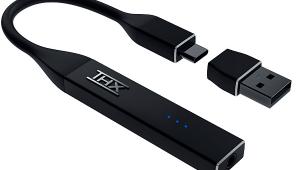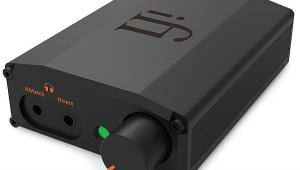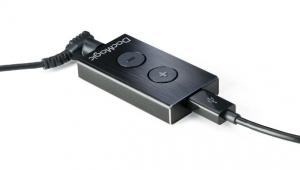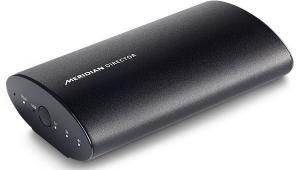iPhone Home Page 3
iRule
About as far from the keep-it-simple, universal-usability concept as you can get, we find iRule. This is a two-piece solution that delivers truly unprecedented iRemote power and flexibility — with commensurate complication.
As I’ve already mentioned, a two-piece design like iRule requires an infrared-repeater component, which iRule calls a “gateway,” to translate IP commands from your iPhone (via Wi-Fi) to the infrared codes that most A/V components require. But instead of flogging its own hardware, iRule markets existing units from third- party automation-connectivity supplier Global Caché.
The simplest is the iTach IP21R ($95), which our test system incorporated. This provides wired Ethernet input, along with minijack outputs for three channels of IR emission. (A single channel can IR-dose multiple components via multihead IR emitters.) Those lacking twisted-pair near their A/V rack can sub in the iTach WF2IR ($110), which exchanges the Ethernet?jack for a stubby antenna and onboard Wi-Fi. There are Global Caché gateways to route commands to serial-port gear and to contact-closure (relay) systems, which will be of interest mostly to home-automation and security pros. (You can also route commands directly to Ethernet-connected components, without benefit of a gateway.) iRule’s app is free only for a 14-day trial, with a few limitations that shouldn’t affect the DIY-er; after that you must pony up $49.95 for the basic version or $99.95 for a “pro” option tailored toward professional integrators. (This comes in addition to the cost of your hardware gateway.)
Where iRule most distinctly diverges from the other two solutions here is in design and implementation of your custom “handset.” This is where you design layouts and assign touchscreen buttons with IR (or IP) codes, and assemble the logic of what buttons are grouped where, macros, and so on. With iRule, all of this happens “off-line” on a computer (or tablet).
Any Internet-connected Web browser, on any computing platform (Mac, Windows, Linux, or even iOS/Android), can serve as the interface, because the iRule Builder application functions via Google apps, and saves your work “in the cloud” on iRule’s (actually, Google’s, I believe) servers. This is a double-edged sword: You get substantially more powerful and configurable remote design and implementation, and safe, crash- and loss-proof storage, but at the cost of a considerable learning curve. (And it’s a boon for installation pros, who can edit or correct remotes from the office and then re-sync them with customer iPhones, without a physical house call.) But you sacrifice any on-the-fly editability, and you have to commit to learning a design program (the aforementioned Google- powered iRule Builder).
I ran iRule Builder via OSX Safari. Builder deems that you design your virtual remotes from scratch, though basic “panels” of commonly grouped buttons and an encyclopedic library of IR codes organized by brand, type, and model help reduce the workload. This blank-slate approach em- powers you to design a remote whose logical structure and “look and feel” are just the way you and your system dictate, but it also means you’ll need to do a good bit of structural thinking about layouts, links, and commands — more than almost any of the prefabbed solutions, whether standalone or two-piece, demand.
Chances are, you’ll undertake a good bit of redesign, or even fresh starts, before you fully grok the system. The iRule Web site offers a handful of tutorials and a few instructional videos, and there’s also a modestly active user forum. Inevitably, though, DIY-ers are going to perform?— and enjoy — most of the self-helping themselves.
The Builder construction kit is quite complete: There are hundreds of premade button and “background” graphics, and what must surely number thousands of infrared and IP codes in iRule’s voluminous database. (This passed my depth test by including at least some codes for several obsolete rarities, including the decades-defunct Proton TVs.)
There’s also, of course, an IR-learning protocol for still more obscure source remotes, but it’s cumbersome. You use a supplied IR sensor plugged into the iTach gateway, but must first download a separate, standalone iLearn application (Mac or PC only). Then, once you’ve successfully learned a code, you must edit it (for name and, if necessary, any data massaging such as gap or trim). Next, you must copy/paste your code, from iLearn to iRule Builder, into the appropriate Device. Phew!
You can download and edit graphic button sets, and create and import your own, but this process, too, is a bit laborious. It’s far easier to find prefabbed sets from the user community on iRule’s online community forums, though these resources, while valuable, are fairly sparse.
I didn’t even attempt a finished integrated remote, but I did succeed in making a crude start. The process is eminently doable, and simultaneously kinda fun and kinda frustrating — the skills and mindset required are quite similar to those needed to conceive and produce an elegant Web site. The depth of iRule Builder’s toolbox?is impressive, and I didn’t even crack the cap on its extensive tap/swipe, two-finger swipe, or four-way wrist-flick “gesture” potential. Neither did I enter the world?of iTunes and AirPlay cooperation via iRule’s iTunes Module, nor that of invoking external iOS apps.
In short, iRule is aptly named: It holds the power to rule almost any A/V system, as well as other forms of home automation. But it’s not a casual commitment. Those who choose iRule should be unafraid to think, create, and learn on their own.





























































